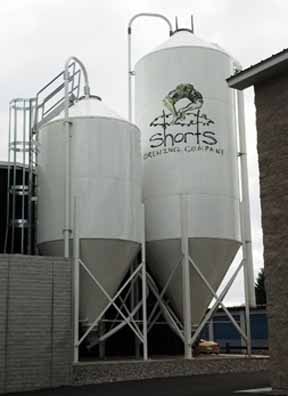This blog first appeared as an article in the spring edition of Craft Beer Quarterly. We hope it provides insight if you’re considering moving up from 50-pound bags to a silo.

From bags to bulk. Is it time to add a silo?
Whether you operate an existing brewery or are in the planning stages for a new one, the idea to add a silo has probably surfaced from time to time.
For more than 20 years Briess has been helping craft brewers answer that question. That’s when some of today’s most successful craft breweries were experiencing their first growing pains. To help, Briess initiated a “Silo Program” designed to walk breweries through the process of installing a silo and become better poised for growth.
Of course the number one reason to install a silo is potential cost savings. As your brewery grows, improving efficiencies and containing costs becomes more and more important. But don’t forget about the added benefits. The mere presence of the silo visually enhances a brewery. And a silo offers valuable marketing real estate for a colorful logo or marketing message. Bulk transfer of malt decreases staff hours and also eliminates back injuries that may come from handling large numbers of 50-pound malt bags. Bulk malt deliveries also decrease the amount of recycling you need to manage. So when is it time for a silo? Here are some things to consider.
Usage
The main criteria for silo readiness is rate of usage. Suggested turnover time for grain stored in a silo (approximately 48,000 pounds) is six to eight weeks. For example, using a 20bbl system, this translates into approximately 60 brews, or two brews a day, five days a week = six weeks for complete usage.
Size
Why 48,000 pounds? That’s based on the size of the silo we recommend for a 20bbl system. We suggest a 1,900-cubic-foot silo which can hold up to approximately 60,000 pounds. This will comfortably hold one truckload (approximately 48,000 pounds) on top of a small amount of grain with sufficient head space. Does the silo need to completely empty before filling it? We suggest the opposite—a small amount of grain in the bottom of the silo acts as a cushion for incoming grain, preventing breakage. We do suggest, however, completely emptying the silo a minimum of 2-4 times every year. This helps remove any build-up of husk and chaff and helps monitor and control any potential problems.
Freight
One of the main reasons we suggest a 60,000-pound-maximum capacity silo is freight. Bulk trucks hold between 48,000 and 50,000 pounds, depending upon the type of truck and density of the grain. The freight bill, however, is based on a minimum of 48,000 pounds per shipment, even if the total is less than that. We therefore suggest that you take full truckloads whenever possible.
Silo Features
So, you fit the above criteria, now what? What features should your new wilo have? Where do you look for a suitable silo? We suggest the following:
1) The hopper should have a 45º minimum angle.
2) The optimum material used for the silo itself should be smooth-sided, epoxy-coated both inside and out—or at the very least a mild steel.
3) The bottom discharge opening should be between 12 and 14 inches.
4) Install a permanently mounted ladder with a safety cage.
5) Further measures should be taken to prevent unauthorized entry into the silo or surrounding area. Become familiar with confined space guidelines including federal, state and any local guidelines that may apply.
6) Filling the silo/unloading the truck: We suggest that you permanently mount a four-inch line equipped with a quick-connect coupling for ease of unloading.
7) Be sure the coupling and all connections are filed smooth. This can be an area that will cause a great deal of damage to grain if not smooth.
8) Install an air vent equipped with a dust collecting cyclone or filter sock. If using a filter sock, we suggest that it is at working level so that a person of average height can stand on the ground to replace the sock.
Making the plunge
If you’re thinking of adding a silo to your operation please contact us first. While we have discussed several major considerations, there are more. Bulk transfer equipment/systems that cause the least amount of breakage to malt, bulk deliveries and ROI are all additional areas which we can advise you on. And, as we all know, every brewery is different. What’s right for one will not be right for another. We’ll be happy to guide you through the process to help decide if it’s time for a silo. Cheers!


